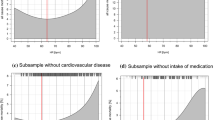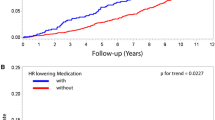Abstract
Resting heart rate has been related to the risk of cardiovascular disease and sudden death in several large prospective studies. To investigate prospectively the association of novel heart rate parameters and of carotid artery stiffness with sudden death and other cardiovascular disease. The Paris Prospective Study III (PPS3) is a new, ongoing French prospective study. From June 2008 to December 2011, 10,000 men and women aged 50–75 years who will have a preventive medical check-up at the Centre d’Investigations Préventives et Cliniques in Paris (France), will be enrolled in the study, after signing an informed consent. In addition to the general health examination, each subject’s heart rhythm will be recorded during the course of the health check-up (approximately 21/2 h) and an echo-tracking of the right carotid bulb will be performed by trained technicians. A bio bank and DNA bank will be established for further biomarker and genetic analyses. The occurrence of cardiovascular disease including acute coronary syndrome, stroke, peripheral artery disease and sudden death, and of mortality, of the participants will be followed up during 20 years. With an estimated mean annual rate of sudden death of 0.1% and its increasing incidence rate with age, between 250 and 300 sudden deaths are expected. This unique study should provide new insights into the regulation of heart rate and blood pressure and should enable to identify novel heart rate parameters that are associated with sudden death.
Similar content being viewed by others
References
Zipes DP, Wellens HJ. Sudden cardiac death. Circulation. 1998;98(21):2334–51.
Atwood C, Eisenberg MS, Herlitz J, et al. Incidence of EMS-treated out-of-hospital cardiac arrest in Europe. Resuscitation. 2005;67(1):75–80.
Albert CM, Chae CU, Grodstein F, et al. Prospective study of sudden cardiac death among women in the United States. Circulation. 2003;107(16):2096–101.
La Rovere MT, Pinna GD, Hohnloser SH, et al. Baroreflex sensitivity and heart rate variability in the identification of patients at risk for life-threatening arrhythmias: implications for clinical trials. Circulation. 2001;103(16):2072–7.
Jouven X, Zureik M, Desnos M, et al. Resting heart rate as a predictive risk factor for sudden death in middle-aged men. Cardiovasc Res. 2001;50(2):373–8.
Jouven X, Empana JP, Schwartz PJ, et al. Heart-rate profile during exercise as a predictor of sudden death. N Engl J Med. 2005;352(19):1951–8.
Jouven X, Schwartz PJ, Escolano S, et al. Excessive heart rate increase during mild mental stress in preparation for exercise predicts sudden death in the general population. Eur Heart J. 2009;30(14):1703–10.
Kornet L, Hoeks AP, Janssen BJ, et al. Carotid diameter variations as a non-invasive tool to examine cardiac baroreceptor sensitivity. J Hypertens. 2002;20(6):1165–73.
Laurent S, Boutouyrie P, Asmar R, et al. Aortic stiffness is an independent predictor of all-cause and cardiovascular mortality in hypertensive patients. Hypertension. 2001;37(5):1236–41.
Laurent S, Cockcroft J, Van Bortel L, et al. Expert consensus document on arterial stiffness: methodological issues and clinical applications. Eur Heart J. 2006;27(21):2588–605.
Benetos A, Thomas F, Bean KE, et al. Role of modifiable risk factors in life expectancy in the elderly. J Hypertens. 2005;23(10):1803–8.
Meinders JM, Brands PJ, Willigers JM, et al. Assessment of the spatial homogeneity of artery dimension parameters with high frame rate 2-D B-mode. Ultrasound Med Biol. 2001;27(6):785–94.
Meinders JM, Kornet L, Hoeks AP. Assessment of spatial inhomogeneities in intima media thickness along an arterial segment using its dynamic behavior. Am J Physiol Heart Circ Physiol. 2003;285(1):H384–91.
Tropeano AI, Boutouyrie P, Katsahian S, et al. Glucose level is a major determinant of carotid intima-media thickness in patients with hypertension and hyperglycemia. J Hypertens. 2004;22(11):2153–60.
Paini A, Boutouyrie P, Calvet D, et al. Carotid and aortic stiffness: determinants of discrepancies. Hypertension. 2006;47(3):371–6.
Tropeano AI, Boutouyrie P, Pannier B, et al. Brachial pressure-independent reduction in carotid stiffness after long-term angiotensin-converting enzyme inhibition in diabetic hypertensives. Hypertension. 2006;48(1):80–6.
Beaussier H, Masson I, Collin C, et al. Carotid plaque, arterial stiffness gradient, and remodeling in hypertension. Hypertension. 2008;52(4):729–36.
Van Bortel LM, Balkestein EJ, van der Heijden-Spek J, et al. Noninvasive assessment of local arterial pulse pressure: comparison of applanation tonometry and echo-tracking. J Hypertens. 2001;19:1037–44.
Kornet L, Hoeks AP, Janssen BJ, et al. Neural activity of the cardiac baroreflex decreases with age in normotensive and hypertensive subjects. J Hypertens. 2005;23(4):815–23.
Goldberger JJ, et al. American Heart Association/American College of Cardiology Foundation/Heart Rhythm Society scientific statement on noninvasive risk stratification techniques for identifying patients at risk for sudden cardiac death: a scientific statement from the American Heart Association Council on Clinical Cardiology Committee on Electrocardiography and Arrhythmias and Council on Epidemiology and Prevention. Circulation. 2008;118(14):1497–518.
Lahiri MK, Kannankeril PJ, Goldberger JJ. Assessment of autonomic function in cardiovascular disease: physiological basis and prognostic implications. J Am Coll Cardiol. 2008;51(18):1725–33.
La Rovere MT, Bigger JT Jr, Marcus FI, et al. Baroreflex sensitivity and heart-rate variability in prediction of total cardiac mortality after myocardial infarction. ATRAMI (Autonomic Tone and Reflexes After Myocardial Infarction) Investigators. Lancet. 1998;351(9101):478–84.
Task Force of the European Society of Cardiology and the North American Society of Pacing and Electrophysiology. Heart rate variability: standards of measurement, physiological interpretation and clinical use. Circulation. 1996;93(5):1043–1065.
Mattace-Raso FU, van den Meiracker AH, Bos WJ, et al. Arterial stiffness, cardiovagal baroreflex sensitivity and postural blood pressure changes in older adults: the Rotterdam Study. J Hypertens. 2007;25(7):1421–6.
Chapleau MW, Abboud FM. Neuro-cardiovascular regulation: from molecules to man. Introduction. Ann N Y Acad Sci 2001 June;940:xiii–xxii.
Chapleau MW, Cunningham JT, Sullivan MJ, et al. Structural versus functional modulation of the arterial baroreflex. Hypertension. 1995;26(2):341–7.
Somers VK, Mark AL, Abboud FM. Interaction of baroreceptor and chemoreceptor reflex control of sympathetic nerve activity in normal humans. J Clin Invest. 1991;87(6):1953–7.
Bots ML, Grobbee DE. Intima media thickness as a surrogate marker for generalised atherosclerosis. Cardiovasc Drugs Ther. 2002;16(4):341–51.
Dijk JM, Algra A, van der GY, et al. Carotid stiffness and the risk of new vascular events in patients with manifest cardiovascular disease. The SMART study. Eur Heart J. 2005;26(12):1213–20.
Bots ML, Baldassarre D, Simon A, et al. Carotid intima-media thickness and coronary atherosclerosis: weak or strong relations? Eur Heart J. 2007;28(4):398–406.
Swierblewska E, Hering D, Kara T, et al. An independent relationship between muscle sympathetic nerve activity and pulse wave velocity in normal humans. J Hypertens. 2010;28(5):979–84.
Hering D, Nowak R, Czechowicz K, et al. Relationship between carotid artery properties, muscle sympathetic nerve activity and cardiovascular variability. Annual congress of European Society of Hypertension 2011 (abstract).
Laude D, Elghozi JL, Girard A, et al. Comparison of various techniques used to estimate spontaneous baroreflex sensitivity (the EuroBaVar study). Am J Physiol Regul Integr Comp Physiol. 2004;286(1):R226–31.
Acknowledgments
Erwan Bozec for the training of the technicians in echotracking. Dr MF Eprinchard, Dr JM Kirzin and all the medical and technical staff of the IPC. Centre de Ressources Biologiques de l’hôpital G Pompidou staff: C de Toma, B Vedie. The Platform for Biological Resources (PRB) of the Hôpital Européen Georges Pompidou (HEGP) for the management of the biobank. The PPS3 is organized under an agreement between INSERM and the IPC Centre, between INSERM and the Centre de Ressources Biologiques de l’Hôpital Europeén Georges Pompidou (HEGP). We thank the Caisse Nationale d’Assurance Maladie des Travailleurs Salariés (CNAM-TS, France) and the Caisse Primaire d’Assurance Maladie de Paris (CPAM-P, France) for helping make this study possible. The PPS3 Study was funded by grants from The National Research Agency (ANR), the Research Foundation for Hypertension (FRHTA), the Research Institute in Public Health (IRESP) and from the Region Ile de France (Domaine d’Intérêt Majeur) in France.
Conflict of interest
None declared.
Author information
Authors and Affiliations
Consortia
Corresponding author
Rights and permissions
About this article
Cite this article
Empana, JP., Bean, K., Guibout, C. et al. Paris Prospective Study III: a study of novel heart rate parameters, baroreflex sensitivity and risk of sudden death. Eur J Epidemiol 26, 887–892 (2011). https://doi.org/10.1007/s10654-011-9618-x
Received:
Accepted:
Published:
Issue Date:
DOI: https://doi.org/10.1007/s10654-011-9618-x




